Arlen Holder
2020-03-31 02:10:26 UTC
Mounted & balanced a set of tires for one of my kids' friends this weekend
<Loading Image...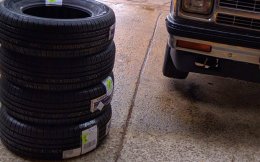 >
>
On brand new steel wheels the kids bought (of unknown-to-me brand or size):
<Loading Image...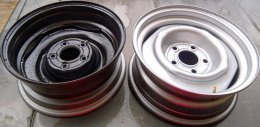 >
>
Where I'd like to ask other adults for purposefully helpful advice so that
I can learn from your experience as this is my first ever mounting &
statically balancing new tires on a brand new set of steel wheels at home.
o Laufenn "G Fit as tires: 215/65R15 95H, TW=500, TR=A, TMP=A
1. These tires had both red (shape) & yellow (weight) dots:
<Loading Image...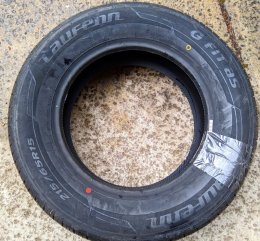 >
>
Where, AFAIK:
o red = uniformity point of maximum radial force variation of the tire
(i.e., difference between the highest & lowest weight points)
(aka the tires' point of maximum radial force and runout)
(aka the tires' high point)
to be aligned to the steel rim's point of minimum radial run-out
(i.e., to be aligned to the steel wheels' low point)
o yellow = the point of lightest weight of the tire
to be aligned with the valve stem on the wheel assembly
which represents the heaviest weight point of the wheel assembly
2. We followed the "red rules over yellow" maxim by marking the rim in
front where this white paint mark was on the back of each rim:
<Loading Image... >
>
3. But since the steel wheels were new, is _this_ mere paint dot on
the inside of each rim the actual match mounting indicator?
<Loading Image... >
>
4. Other than that white paint dot, we couldn't find low-point dimples
or scratches, or other indications on the steel wheels:
<Loading Image... >
>
5. So we simply matched the red tire mark to the steel rim white paint dot:
<Loading Image...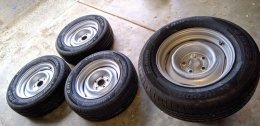 >
>
6. In addition, the old wheels were quite different in size than the new,
where the new wheels were the stock size for this vehicle & the old
wheels were completely different in size, shape, & depth:
<Loading Image...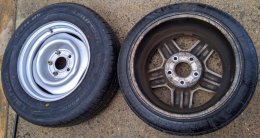 >
>
7. But what was strange about the front axle, was this aluminum spacer:
<Loading Image...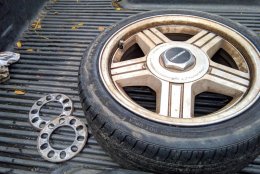 >
>
8. And what was even stranger about the rear axle was this steel and
aluminum spacer assembly:
<Loading Image...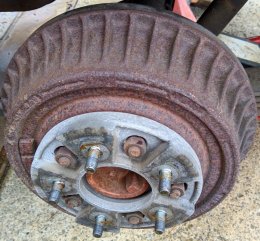 >
>
9. The boys asked me if they should keep or ditch the spacer, but I simply
didn't have a clue since I have never encountered such things before.
<Loading Image...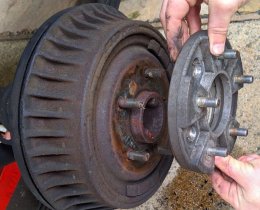 >
>
10. I suspect they were needed perhaps due to the depth of the old wheels:
<Loading Image...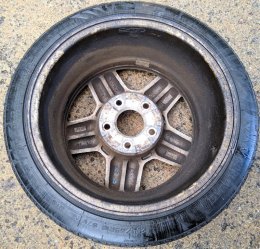 >
>
11. Where the rear axle had a much thicker spacer than the front axle did:
<Loading Image...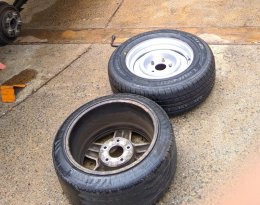 >
>
12. Where in the end, we opted to remove all the spacers on both axles:
<Loading Image...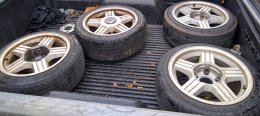 >
>
13. Where the original lug nuts on the front axle seemed to fit well on the
front lug bolts:
<Loading Image...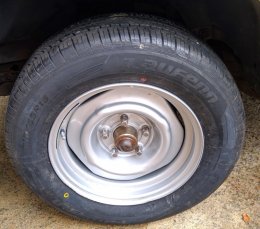 >
>
14. But for the rear axle, the lug nuts that were holding together the
two-piece rear spacer seemed to fit the lug bolts better.
<Loading Image...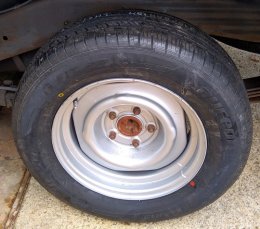 >
>
In summary, what advice would you give if you have mounted and balanced
tires on new steel wheels at home?
NOTE: I've done SUV tires many times before, but on old steel wheels,
where, in the past, SUV tires were a pain to seal the bead as compared to
sedan tires, but the SUV tires were relatively easy to mount onto the steel
rims (as opposed to sedan tires on both steel & alloy wheels); whereas
these LT tires were the complete opposite of my prior SUV tire experience!
o These LT tires were a pain to get onto the rim, but,
o They sealed so trivially that it took _zero_ force to pop in the bead.
The fit was so tight that I literally popped the bead without any holding
of the tire whatsoever to seat the bead. It was _that_ tight on the rim.
NOTE: Dynamic balance test is free, where the kid reported zero vibration
at speed, but where I told him Costco will balance any wheel for around
five bucks a wheel (an extra 50 cents per wheel if they're on the vehicle),
so dynamic balance is assured due to two simple things:
a. The on-the-road dynamic balance test is always constant & free, and,
b. The Costco dynamic balance, if needed, is only five bucks per wheel.
We didn't need to dispose the old tires, but here in California, Costco
takes back worn carcasses for $1 each plus about 10% sales tax
(why there's a _second_ sales tax on tires is beyond my pay grade).
NOTE: I have a separate bead breaker, but we didn't need it for this job
because the kid kept the old wheels and tires.
Note: We didn't put steel clipon weights because you can't get lead weights
in California it seems, and besides, I couldn't find them when we needed
them, so we were stuck with ounce and half ounce stickon California
non-lead alloy wheel weights.
Note: We used the snap in (rubber boot) brass shielded tire valves because
the kids forgot to buy their own, so those were the only ones I have since
I used up all my bolt on 0.453" tire valves on the last mounting job.
Note: We used liquid dish detergent for lube, where these tires were super
tight, like I've never seen tires be (where I've mounted, oh, about 40
tires in the last handful of years, give or take a few tires).
Note: It's about $20 per wheel (plus usually around 3 to 7 bucks each for
disposal, plus around 3 to 4 bucks each for valves) for mounting and
dynamic balancing which we saved for this kid, in addition to taxes and
shipping, all of which was free since we bought out of state.
And of course, the local tire shops _never_ bother to match mount.
<Loading Image...
On brand new steel wheels the kids bought (of unknown-to-me brand or size):
<Loading Image...
Where I'd like to ask other adults for purposefully helpful advice so that
I can learn from your experience as this is my first ever mounting &
statically balancing new tires on a brand new set of steel wheels at home.
o Laufenn "G Fit as tires: 215/65R15 95H, TW=500, TR=A, TMP=A
1. These tires had both red (shape) & yellow (weight) dots:
<Loading Image...
Where, AFAIK:
o red = uniformity point of maximum radial force variation of the tire
(i.e., difference between the highest & lowest weight points)
(aka the tires' point of maximum radial force and runout)
(aka the tires' high point)
to be aligned to the steel rim's point of minimum radial run-out
(i.e., to be aligned to the steel wheels' low point)
o yellow = the point of lightest weight of the tire
to be aligned with the valve stem on the wheel assembly
which represents the heaviest weight point of the wheel assembly
2. We followed the "red rules over yellow" maxim by marking the rim in
front where this white paint mark was on the back of each rim:
<Loading Image...
3. But since the steel wheels were new, is _this_ mere paint dot on
the inside of each rim the actual match mounting indicator?
<Loading Image...
4. Other than that white paint dot, we couldn't find low-point dimples
or scratches, or other indications on the steel wheels:
<Loading Image...
5. So we simply matched the red tire mark to the steel rim white paint dot:
<Loading Image...
6. In addition, the old wheels were quite different in size than the new,
where the new wheels were the stock size for this vehicle & the old
wheels were completely different in size, shape, & depth:
<Loading Image...
7. But what was strange about the front axle, was this aluminum spacer:
<Loading Image...
8. And what was even stranger about the rear axle was this steel and
aluminum spacer assembly:
<Loading Image...
9. The boys asked me if they should keep or ditch the spacer, but I simply
didn't have a clue since I have never encountered such things before.
<Loading Image...
10. I suspect they were needed perhaps due to the depth of the old wheels:
<Loading Image...
11. Where the rear axle had a much thicker spacer than the front axle did:
<Loading Image...
12. Where in the end, we opted to remove all the spacers on both axles:
<Loading Image...
13. Where the original lug nuts on the front axle seemed to fit well on the
front lug bolts:
<Loading Image...
14. But for the rear axle, the lug nuts that were holding together the
two-piece rear spacer seemed to fit the lug bolts better.
<Loading Image...
In summary, what advice would you give if you have mounted and balanced
tires on new steel wheels at home?
NOTE: I've done SUV tires many times before, but on old steel wheels,
where, in the past, SUV tires were a pain to seal the bead as compared to
sedan tires, but the SUV tires were relatively easy to mount onto the steel
rims (as opposed to sedan tires on both steel & alloy wheels); whereas
these LT tires were the complete opposite of my prior SUV tire experience!
o These LT tires were a pain to get onto the rim, but,
o They sealed so trivially that it took _zero_ force to pop in the bead.
The fit was so tight that I literally popped the bead without any holding
of the tire whatsoever to seat the bead. It was _that_ tight on the rim.
NOTE: Dynamic balance test is free, where the kid reported zero vibration
at speed, but where I told him Costco will balance any wheel for around
five bucks a wheel (an extra 50 cents per wheel if they're on the vehicle),
so dynamic balance is assured due to two simple things:
a. The on-the-road dynamic balance test is always constant & free, and,
b. The Costco dynamic balance, if needed, is only five bucks per wheel.
We didn't need to dispose the old tires, but here in California, Costco
takes back worn carcasses for $1 each plus about 10% sales tax
(why there's a _second_ sales tax on tires is beyond my pay grade).
NOTE: I have a separate bead breaker, but we didn't need it for this job
because the kid kept the old wheels and tires.
Note: We didn't put steel clipon weights because you can't get lead weights
in California it seems, and besides, I couldn't find them when we needed
them, so we were stuck with ounce and half ounce stickon California
non-lead alloy wheel weights.
Note: We used the snap in (rubber boot) brass shielded tire valves because
the kids forgot to buy their own, so those were the only ones I have since
I used up all my bolt on 0.453" tire valves on the last mounting job.
Note: We used liquid dish detergent for lube, where these tires were super
tight, like I've never seen tires be (where I've mounted, oh, about 40
tires in the last handful of years, give or take a few tires).
Note: It's about $20 per wheel (plus usually around 3 to 7 bucks each for
disposal, plus around 3 to 4 bucks each for valves) for mounting and
dynamic balancing which we saved for this kid, in addition to taxes and
shipping, all of which was free since we bought out of state.
And of course, the local tire shops _never_ bother to match mount.
--
Usenet is a place for adults to gather to politely discuss technical stuff.
Usenet is a place for adults to gather to politely discuss technical stuff.